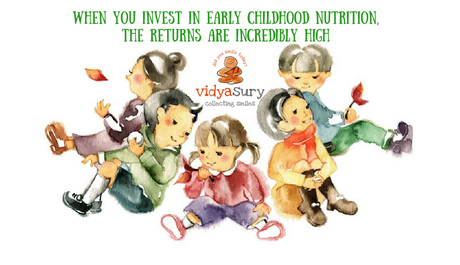
My son returned to college three weeks ago. Each time I go into the kitchen, the jar of Horlicks looks at me rather sadly, just like all his other staples. I miss the routine of watching him follow his routine. It started with a hug and a "good morning"-then he would drain the water from the cup with almonds soaking. Peel them diligently and offer me some before popping some in his mouth. Then he'd gleefully eat a heaping spoon of Horlicks before drinking the beverage and taking his breakfast to the table where he'd enjoy it.
This has been constant since he was three years old. This November, he'll be 20. And for as long as I live, I'll always keep telling him that eating healthy, living healthy is the most important thing-everything else is secondary. More so, as he studies on campus away from home.
I was lucky that my Mom lived with us and we had the blessing of her expertise on child nutrition when we welcomed my son into this world.
Children experience rapid growth from the time they're born to the age of 6-and I remember how amazing it was to watch my son undergo major physical and psychological changes. He grew tall quite quickly and was head and shoulders above his classmates by the time he was a first grader at the age of 6. Apparently, children achieve 60% adult height and 30% adult weight gain by the age of 6. Also, a child's brain reaches 55% of its adult size by the time she's 2 and by the time she's 6, it is 90% of its adult size.
I smile to think of all the rapid fire questioning we experienced during my son's toddler years and must confess that we did not always have the answers. What we were always conscious of was ensuring that he got the right nutrition to fuel his growth.
Why child nutrition is vital
A very critical thing about a toddler's diet is the right nutrients in the appropriate quantities. Having a healthy diet for children which contains nutrients like carbohydrates, proteins, balanced fat, vitamins, minerals and essential nutrients like DHA and essential fats is important.
It is easy to assume that as mothers, we are providing proper nutrition. However, making sure that a child gets the nutrients she needs over the years is a challenge. During any given day, different food items in different quantities are required to meet the child's nutritional requirements.
On top of this, there is the issue of fussy eaters who simply refuse to eat sometimes, and come up with all sorts of excuses to skip a meal and throw tantrums. When this happens, it is naturally worrisome as the child does not get the nutrition she needs, and this gets in the way of healthy growth.
In my case, I was worried that the small tiffin box my son carried to school would barely be enough. After all, how much breakfast can a child consume when school starts at 7:00 a.m.? I packed rotis, vegetable and fruit, but considering the amount of activity he had, especially on days when they had games, it would seem like he was not eating enough-and would come home, super-hungry.
Did you know that inadequate intake of micronutrients can wreak havoc on our health? This results in a deficiency, causing something called "hidden hunger." Also, looking healthy doesn't always mean being healthy.
Looking healthy doesn't always mean being healthy #RightStartforRightGrowth Click To Tweet
As parents, it is our duty to give our kids a headstart in life, making sure that they eat a varied diet that includes veggies and fruits, and get enough exercise and sleep. The goal is to make sure that their immune system is strong enough to keep them healthy.
I learned a few things about toddler nutrition over the years:
- Toddlers' appetites vary from day to day
- Since their dietary requirements are different from that of adults, toddlers need a diet made up of foods from the four main food groups, in the right balance and in portion sizes just right for them.
- Toddlers' food preferences vary from day to day, so it is important to keep offering them new foods, along with their familiar favorites.
- Toddlers usually manage their own appetite, so we need to encourage them to eat-but not force them to eat if they are not hungry.
- It is not a good idea to force a child to finish her plate.
- This is a really tough one: but it is a bad idea to negotiate with or bribe your child.
See the challenge?
One of the things I relied on is my favorite health food drink-Horlicks-which, I believe, helped my son meet his nutritional requirements.
But you know what? While I am glad that I gave my son Horlicks, I do realize that toddlers are different and their body-brain development is much faster during this stage. Toddlers need tailor made nutrition and this can be met by health food drinks like Junior Horlicks. Today, I recommend it for toddlers and here are the main reasons why:
- 50% more protein*
- 23 nutrients
- Contains DHA and Choline important for brain development function
- Contains nutrients for weight gain
- Contains lesser fat vs. other high fat toddler HFDs
- Contains high protein and milk calcium for height gain
- Contains immunity supporting nutrients for healthy immunity
- Contains nutri-compact formula (nutrient dense, packed with key nutrients)
Of course, our little ones love to eat it just as it is-offering the simple logic that it is tasty-with the natural goodness of milk and cereal. Can't argue with that!
On a serious note, though, it provides tailor made nutrition for those fussy eaters and toddlers and preschoolers-giving them age-appropriate nutrition. More important is the fact that it is based on WHO's nutrient guidelines for this age. Relevant to our family, is the fact that it is vegetarian.
I feel a warm sense of pride when I see my son today-still technically a Horlicks baby-taking care of himself, making sure he eats his meals on time, and enjoying college life.
Health is our only true wealth-and unless we have that in control, life can be really tough.
Here are some tips from what I've learned about cultivating healthy eating habits:
- Offering a variety of foods helps children get the nutrients they need from every food group. This increases the chances of being open to trying new foods and liking them. This makes meal planning easier.
- Showing by example-eat what you expect your child to eat.
- Shopping together-great way to teach children about food and nutrition. Keep up a conversation about where they come from and why making healthy choices is important. Also, it made my shopping quicker and easier as my son loved to look at our list and fill our cart!
- Involving children while cooking and encouraging them to come up with recipes. Total win-win.
- Making the same dishes for everyone in the family. Easier on the cook, whoever that is in the family!
- Not using food as a reward. Hugs and cuddles have always been our go-to-s...followed by books, of course.
- Eating together-you know what they say; the family that eats together...
- Sharing activities together-going for a walk or playing together.
Parents have a tough job being good role models. I am glad I had Horlicks to help, and those of you with toddlers have the extra benefit of Junior Horlicks!
* Basis label claims per daily serve for leading (By Market Share) Health Food Drinks in India

Writer, editor, blogger, social media enthusiast. Love DIY, Coffee, Music, Reading, Photography, Family, Friends and Life. Mantra: Happiness is a DIY Project. In my free time I play with my dust bunnies and show my diabetes who's boss. Tweet as @vidyasury

